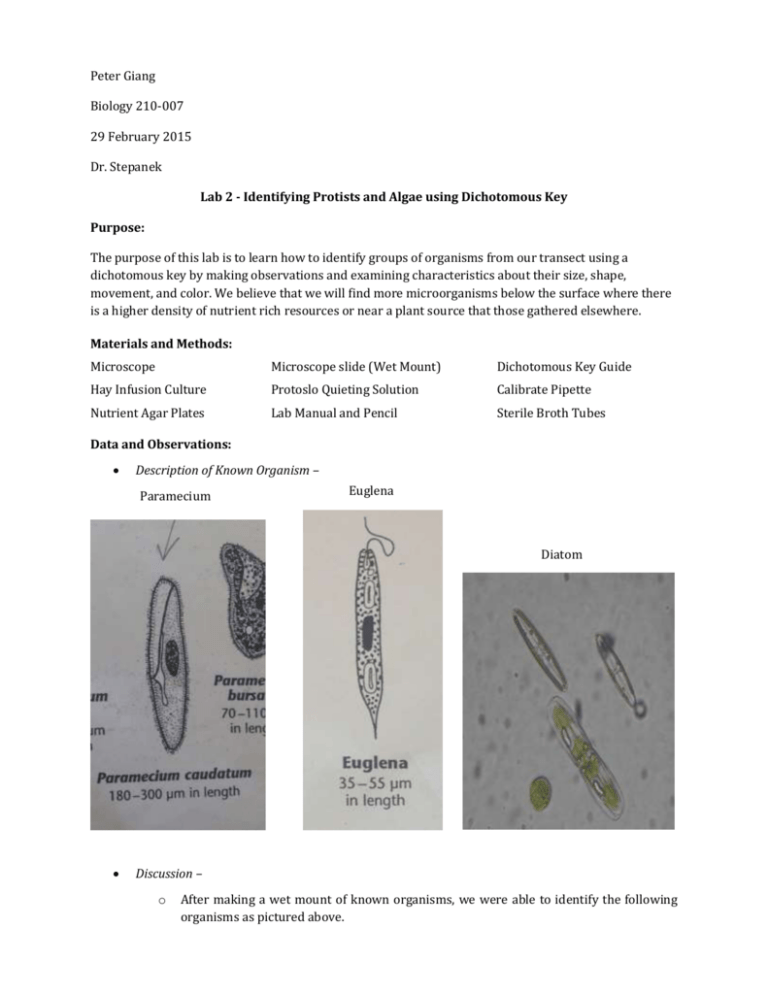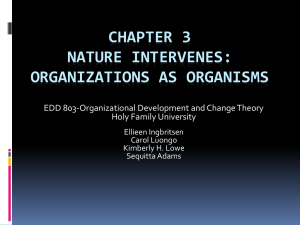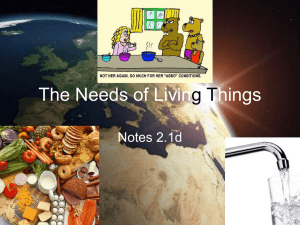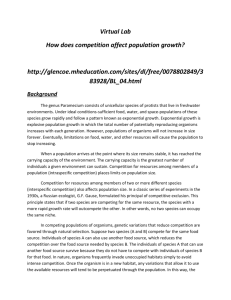BIO_210_-_LAB_2
advertisement

Peter Giang Biology 210-007 29 February 2015 Dr. Stepanek Lab 2 - Identifying Protists and Algae using Dichotomous Key Purpose: The purpose of this lab is to learn how to identify groups of organisms from our transect using a dichotomous key by making observations and examining characteristics about their size, shape, movement, and color. We believe that we will find more microorganisms below the surface where there is a higher density of nutrient rich resources or near a plant source that those gathered elsewhere. Materials and Methods: Microscope Microscope slide (Wet Mount) Dichotomous Key Guide Hay Infusion Culture Protoslo Quieting Solution Calibrate Pipette Nutrient Agar Plates Lab Manual and Pencil Sterile Broth Tubes Data and Observations: Description of Known Organism – Paramecium Euglena Diatom Discussion – o After making a wet mount of known organisms, we were able to identify the following organisms as pictured above. Paramecium – this single-celled protist has a well-defined oval-elongated feature with surrounding cilia allowing them to move quickly through different types of bodies of water mainly rivers, lakes, ponds, and streams (Freeman, Quillin, Allison, 2013) Euglena – another common unicellular protist found in damp places and other bodies of water, this microorganism is structurally distinct from paramecium having a long whip-like tail known as a flagella used for movement (Freeman, Quillin, Allison, 2013) Diatom – these photosynthetic unicellular organisms is an algae that are producers, mainly sugar from sunlight that other organisms eat from (Freeman, Quillin, Allison, 2013). They exist in a variety of forms: from single cells to flock of colonies (Freeman, Quillin, Allison, 2013). Description of Hay Infusion Culture Marsh transect - green shoot, mold, moss, muddled water, brown pigment covering top surface, damp, humid, odorous Abiotic Features – glass jar, water medium, dirt Biotic Features – moss, mold, plant, algae, protists, bacteria, and other microorganisms living in this ecosystem o Organisms Identified from Hay Infusion Culture Colpidium – this microorganism was obtained from a sample collected near the bottom surface of our transect in and around surrounding areas of growing moss Paramecium caudatum This microorganism sample was gathered near the top surface of our culture adjacent to our plant source Bursaria Truncatella – this microorganism was also obtained from a sample collected near the bottom surface of our transect in and around the surrounding growth of moss Conclusions and Future Directions: o In this weeks’ lab, we were able to successfully identify three different types of microorganisms found in our ecosystem grown from our transect using a dichotomous key. We were not able to successfully test our hypothesis because our two water sources were from a plant source and at the bottom of our culture. Our data did show, however that there were more life forms near the bottom of the culture than at the top of the surface (near our plant source. Using protoslo would have been useful while observing organisms from the bottom of our culture although there is a tradeoff. Using this solution may have distorted our observation is correctly identifying these organisms in their movement.










